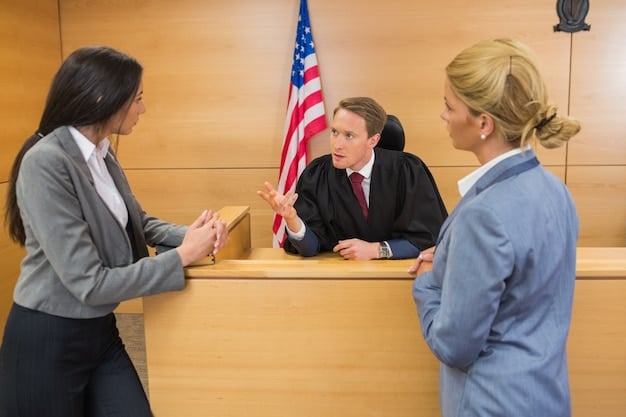US Response to Chemical Weapons Attack in Syria: Options and Implications

How Will the US Respond to a Chemical Weapons Attack in Syria? The US response to a chemical weapons attack in Syria would likely involve a combination of diplomatic, economic, and military actions, tailored to the specific circumstances and designed to deter further attacks and hold perpetrators accountable.
Understanding how will the US respond to a chemical weapons attack in Syria is crucial given the volatile geopolitical landscape. The decision-making process involves multiple considerations, from international law to strategic interests, shaping potential actions on the ground.
Understanding the US Stance on Chemical Weapons
The United States has consistently condemned the use of chemical weapons, viewing it as a violation of international norms and a threat to global security. This stance is deeply rooted in both moral imperatives and strategic considerations.
Historical Context and Treaties
The US commitment against chemical weapons can be traced back through various international agreements and treaties, including the Chemical Weapons Convention (CWC). These agreements reflect a global consensus aimed at banning the production, stockpiling, and use of chemical weapons.
Red Lines and Consequences
Over the years, the US has articulated specific “red lines” regarding the use of chemical weapons, particularly in conflict zones like Syria. Crossing these lines has often been met with strong responses, ranging from diplomatic pressure to military action.

Here are key elements of the US stance:
- Zero Tolerance: The US maintains a zero-tolerance policy for the use of chemical weapons.
- International Law: The US adheres to international laws and treaties prohibiting chemical warfare.
- Accountability: The US seeks to hold accountable those responsible for using chemical weapons.
In conclusion, the US stance on chemical weapons is firm, driven by a commitment to international law, human rights, and global security. This foundation significantly influences potential responses to chemical attacks, particularly in regions like Syria where such threats persist.
Scenarios Triggering a US Response
Several scenarios could prompt the United States to respond to a chemical weapons attack in Syria. These scenarios generally involve clear evidence of chemical weapon use, significant harm to civilians, or a direct threat to US interests or allies.
Confirmed Use of Chemical Weapons
A confirmed instance of chemical weapons use, verified by credible sources and international organizations, is a primary trigger. Verification typically involves on-site investigations, sample analysis, and intelligence assessments.
Mass Civilian Casualties
If a chemical attack results in mass civilian casualties, the US is more likely to intervene. The scale of human suffering often compels action, driven by humanitarian concerns and the need to prevent further atrocities.
Threat to US Allies and Partners
Direct threats to US allies or partners in the region can also trigger a US response. Protecting allies is a cornerstone of US foreign policy, and inaction could undermine regional stability and US credibility.

Here are key factors influencing the decision to respond:
- Evidence of Use: Concrete evidence confirming the use of chemical weapons.
- Impact on Civilians: The extent of harm inflicted on the civilian population.
- Strategic Interests: Protecting US allies and maintaining regional stability.
In summary, the US response is contingent upon clear evidence, significant humanitarian impact, and threats to strategic allies. These conditions define the threshold for potential intervention and guide the nature of the response.
Potential US Response Options
The United States has a range of response options available following a chemical weapons attack in Syria. These options span diplomatic efforts, economic sanctions, and military actions, with each tailored to specific circumstances and objectives.
Diplomatic and Political Measures
Diplomatic responses often involve condemnation through international forums such as the United Nations. The US may also lead efforts to impose sanctions on individuals and entities responsible for the attack.
Economic Sanctions
Economic sanctions can target key sectors of the Syrian economy, aiming to pressure the regime to cease its support for chemical weapons programs. Sanctions may also target individuals involved in the production or use of these weapons.
Military Options
Military responses can range from limited strikes on chemical weapons facilities to broader campaigns aimed at degrading the Syrian military’s capabilities. These actions are often coordinated with allies to maximize effectiveness and legitimacy.
Potential military actions might include:
- Airstrikes: Targeted strikes against chemical weapons storage and production sites.
- Missile Strikes: Using cruise missiles to destroy key infrastructure.
- Support for Opposition Forces: Providing assistance to groups fighting the Syrian regime.
Ultimately, the US response will likely involve a combination of diplomatic, economic, and military tools, carefully calibrated to achieve specific objectives and minimize unintended consequences. This multifaceted approach underscores the complexity of responding to chemical weapons attacks in a volatile region.
Legal and Ethical Considerations
Legal and ethical considerations play a significant role in shaping the US response to a chemical weapons attack in Syria. These considerations guide the decision-making process, balancing the need for action with adherence to international law and moral principles.
International Law and Justification
Any US military intervention must be justified under international law, typically through the principle of self-defense or with the authorization of the UN Security Council. However, obtaining such authorization can be challenging given geopolitical dynamics.
Ethical Responsibilities
Ethical considerations involve weighing the potential harm to civilians against the benefits of military action. The principle of proportionality requires that the response be proportionate to the threat, minimizing unintended consequences.
Avoiding Escalation
The risk of escalation is a key concern, particularly given the involvement of multiple actors in the Syrian conflict. The US must carefully calibrate its response to avoid triggering a wider regional conflict.
Key ethical principles include:
- Proportionality: Ensuring the response is proportionate to the threat.
- Discrimination: Targeting military objectives while minimizing harm to civilians.
- Humanity: Acting in a manner consistent with humanitarian principles.
In conclusion, legal and ethical considerations are central to the US decision-making process. These factors ensure that any response is grounded in international law, moral principles, and a commitment to minimizing harm and avoiding escalation.
The Role of International Allies
The role of international allies is crucial in shaping the US response to a chemical weapons attack in Syria. Collaboration with allies can enhance the legitimacy and effectiveness of any action, sharing the burden and bolstering international support.
Building Coalitions
The US often seeks to build coalitions oflike-minded nations to support its actions. These coalitions can provide military, economic, and diplomatic support, enhancing the impact of the response.
Sharing Intelligence and Resources
Allies can share intelligence and resources, providing valuable insights into the situation on the ground and helping to identify those responsible for the attack. This collaboration can improve the accuracy and effectiveness of targeted actions.
Diplomatic Support
Allies can provide diplomatic support, lobbying for international condemnation of the attack and supporting efforts to hold perpetrators accountable. This unified front can increase pressure on the Syrian regime and its allies.
The collaboration with allies includes:
- Joint Military Operations: Conducting airstrikes or other military actions in coordination with allies.
- Sanctions and Economic Pressure: Imposing coordinated sanctions to maximize economic impact.
- Diplomatic Initiatives: Working together to achieve diplomatic resolutions and accountability.
In summary, the involvement of international allies is essential for a comprehensive and effective response. By sharing resources, intelligence, and diplomatic support, allies can enhance the impact of the US actions and promote a more unified international front.
Potential Consequences and Risks
The United States must carefully consider the potential consequences and risks associated with any response to a chemical weapons attack in Syria. These considerations include the risk of escalation, unintended harm to civilians, and broader regional instability.
Risk of Escalation
Military action can escalate the conflict, drawing in other regional actors and increasing the risk of a wider war. Careful planning and communication are essential to mitigate this risk.
Unintended Harm to Civilians
Military strikes can result in unintended harm to civilians, particularly in densely populated areas. Efforts must be made to minimize civilian casualties and protect vulnerable populations.
Regional Instability
The US response can have broader implications for regional stability, potentially exacerbating existing tensions and creating new conflicts. A comprehensive strategy is needed to address these potential consequences.
The assessment of risks involves:
- Military Escalation: Assessing the potential for military action to escalate the conflict.
- Humanitarian Impact: Evaluating the impact on civilian populations and humanitarian efforts.
- Geopolitical Stability: Considering the broader implications for regional and international stability.
In conclusion, a thorough assessment of potential consequences and risks is essential for informed decision-making. By carefully weighing these factors, the US can develop a response that is both effective and responsible, minimizing harm and promoting stability.
| Key Point | Brief Description |
|---|---|
| 🛡️ US Stance | Zero tolerance for chemical weapons use, adhering to international law. |
| ⚠️ Trigger Scenarios | Confirmed use, mass casualties, or threats to US allies prompt response. |
| Options | Diplomacy, sanctions, and military actions tailored to circumstances. |
| 🌍 Allies’ Role | Collaboration enhances legitimacy, intelligence sharing, and diplomatic unity. |
Frequently Asked Questions
▼
A chemical weapons attack involves the use of toxic chemicals to cause harm or death. This includes employing nerve agents, blister agents, or other hazardous substances as weapons in conflict.
▼
Verification involves gathering evidence through on-site inspections, sample analysis by laboratories, intelligence assessments, and reports from credible sources like international organizations and NGOs.
▼
The Chemical Weapons Convention (CWC) is the primary international treaty banning the production, stockpiling, and use of chemical weapons. It is a key component of international law on this issue.
▼
Military actions could include targeted airstrikes on chemical weapons facilities, missile strikes on key infrastructure, or support for opposition forces fighting against the Syrian regime.
▼
Allies contribute by sharing intelligence, providing military support, imposing coordinated sanctions, and offering diplomatic backing to condemn the attack and hold responsible parties accountable.
Conclusion
In conclusion, the US response to a chemical weapons attack in Syria is a complex and multifaceted issue, involving a range of legal, ethical, and strategic considerations. The decision-making process requires careful balancing of the need for action with the potential risks and consequences, ensuring that any response is both effective and responsible in promoting stability and upholding international norms.





